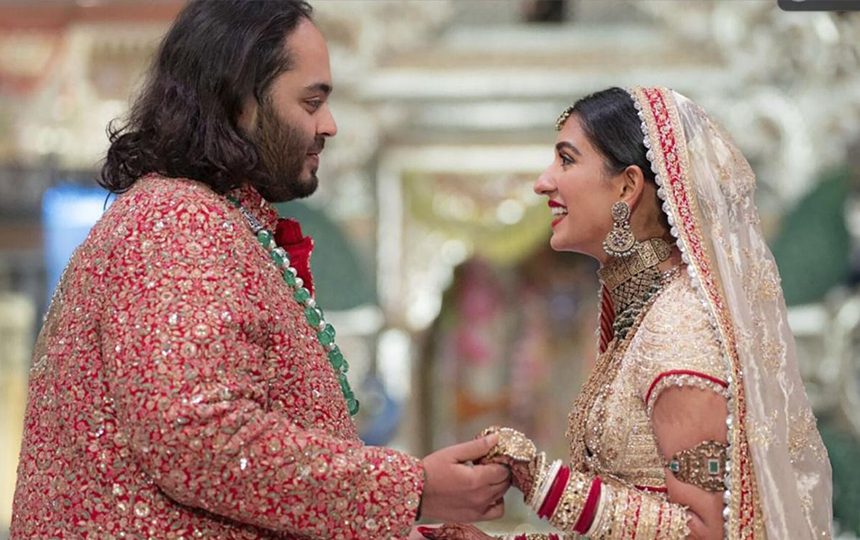Anant Ambani, son of India’s richest man Mukesh Ambani, recently married Radhika Merchant, sparking a global debate on wealth, environmental impact, and social responsibility. The five-month-long celebration, estimated to cost between $480-600 million, sparked questions about the ethics of such displays in a country grappling with poverty.
The Ambani-Merchant wedding featured performances by global stars like Rihanna, Justin Bieber, and Katy Perry. Guests, including celebrities and politicians, were flown in on private jets. The celebrations included a luxury cruise in the Mediterranean for 800 guests, and the family wore extravagant jewellery, including a $53.8 million emerald necklace worn by the groom’s mother. The groom wore a gold-embroidered outfit worth $25.6 million. This wedding divided public opinion, with some calling it “lavish” and “spectacular,” and others calling it “obscene” and “vulgar.”
The wedding’s environmental impact is a major talking point. Hundreds of private planes flew guests to different events, each jet releasing about 2 tons of carbon per hour – as much as an average Indian produces in a year. The Mediterranean cruise may have produced 1,350 tons of carbon emissions.
Luxury cars drove guests during the five-month celebration, increasing the carbon footprint. This comes as the world fights climate change, with the United Nations and other groups urging eco-friendly living. The Ambani wedding contradicts this advice, raising questions about the responsibility of the ultra-wealthy in addressing environmental challenges.
The wedding highlighted how wealth can influence systems. The Indian government allowed a military airport for guests, parts of an Italian village were closed for the family’s cruise stop, and in Mumbai, traffic was blocked near the wedding venue. These arrangements have led some to question if the very rich get too many privileges, potentially at the expense of the public.
The contrast between the wedding’s extravagance and India’s economic reality is stark. The average Indian earns about $2,500 a year, much less than the world average of $13,138, making this Indian wedding possibly the most expensive in recent world history. This dichotomy has sparked a national conversation about inequality and the growing wealth gap in India. Some are proud of the global fame, while others worry about the widening rich-poor gap in India.
The groom, Anant Ambani, supports wildlife conservation and leads a project called Vantara to help endangered animals. However, his wedding choices seem to contradict his environmental work. He wore a crocodile-skin jacket at one event, and the wedding’s huge carbon footprint contradicts environmental protection efforts. This has made people question his environmental advocacy sincerity.
Keep Read: Climate change alters earth’s rotation, lengthening days: Study
Public opinion is changing towards greater environmental awareness and the role of the wealthy in climate change. A Yoot survey found that 78.78% of respondents think the government should limit private jets at big events to help the environment, and 68.47% believe very rich people are more responsible for climate change. These results show that many, especially younger generations, are increasingly concerned about the environmental impact of the very rich.
The Ambani wedding highlights global inequality and climate impact. Studies show the richest 1% produce more pollution than the poorest 50%, posing a challenge to global climate goals. Food waste at Indian weddings is significant, feeding thousands. India lacks strong pollution control rules for the rich, highlighting a policy gap.
In response to these issues, there are growing calls for change – higher taxes on the rich, stricter private jet regulations, more focus on renewable energy, and better food waste management at big events. Some argue it’s unfair to blame farmers or regular people for pollution when the rich produce much more.
The wedding had a political angle. India’s top political leaders, including Prime Minister Narendra Modi, attended, sparking questions about potential government rules that might upset them, highlighting the complex relationship between wealth and political influence in India.
The Ambani wedding has sparked conversations about the environmental impact of the very rich, extravagant spending in a country with widespread poverty, and government control of pollution from luxury lifestyles. While a happy event for the Ambani family, it’s also a symbol of bigger societal issues.





